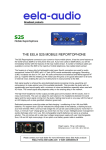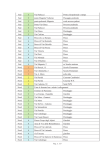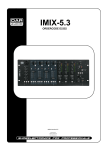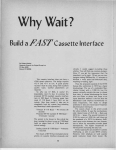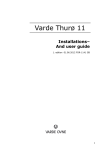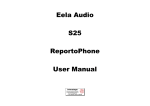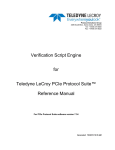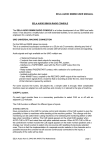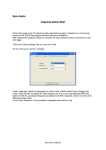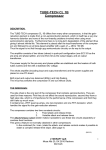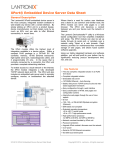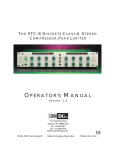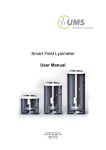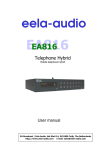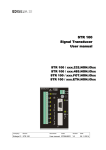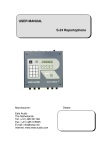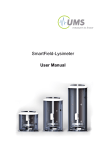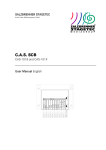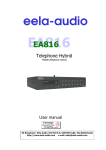Download Manual S20A - Eela Audio
Transcript
eela-audio Broadcast products S20A S20A Reportophone EELA S20A REPORTOPHONE® USER MANUAL http:// www.eela-audio.com e-mail: [email protected] EELA AUDIO S20A REPORTOPHONE® USERS MANUAL 1. APPLICATIONS The EELA AUDIO S20A REPORTOPHONE® can be seen as a universal, multifunctional tool for the radioreporter. Except for the primary purpose, sending programm-contributions to the studio via the public telephone-net, a number of extra facilities is available, shown very useful in practice. These facilities are: 1. Making a connection with the studio and sending contributions via microphone and/or tape with monitoring of the returnsignal, to be mixed with the direct signal. Making the connection can be done with the numeric keypad with a choice of tone- or pulse dialling for use with all kinds of telephonelines. 2. Making a connection for doing a telephone-interview and recording this on a connected tape- or cassetterecorder. The balance between the own contribution (via the microphone) and the contribution from the telephoneline can be adjusted for optimum results. 3. The use of the REPORTOPHONE as portable mixer for recording with inputs for microphone and line/tape with internal compresor/limiter for levelcontrol, a feature very useful as addition to many reportermachines without a good automatic levelcontrolfacility. To enable the use both at home and in the field, the unit can be powered either from the internal batteries or a mainsadapter with automatic changeover. The current consumption is that low, that a set of batteries (2 each 6F22 9 Volt alkaline cells) last for at least 20 hours. Replacing of them can be done quick without any tools 2. CONNECTIONS All connections are located on the backpanel of the REPORTOPHONE®', as much as possible by professional, heavy duty connectors for maximum reliability. Available are: MICROPHONE INPUT (MIC) Made via a fermale XLR, balanced for using almost any kind of dynamic or (professional) electret microphone. The sensitivity can be controlled such, that optimum modulation can be achieved in almost any situation. Connections are: pin 1: screen pin 2: in phase signal (+) pin 3: Out phase signal (-) LINE INPUT (TAPE) Also on a female XLR and balanced. Both professional sources with high level and balanced outputs as consumerequipment with lower level and unbalanced character with higher impedances can be used without problems. Connections are: pin 1: screen pin 2: in phase signal (+) pin 3: Out phase signal (-) When unbalanced sources are used, pin 1 and pin 3 have to be wired together. EELA AUDIO Het Riet 8a Cuijk, The Netherlands, +31485331182 EELA AUDIO S20A REPORTOPHONE® USERS MANUAL RECORD OUTPUT (RECORD) This is an unbalanced output on a male XLR for connection to a line-input of a recorder for recording of the mix of the contribution of the telephoneline and the microphone/tape signal, the same signal that can be heard on the headphone output, Connections are: pin 1: ground/screen pin 2: signal pin 3: ground/screen The level depends mainly on the telephoneline, but is nominal + 6 dBu, direct suited for professional machines. For use with (more sensitive) consumer equipment an in line attenuator of 10 dB, consisting of a 10 kOhm resistor in series and a 4k7 parallel to the machineinput is recommended. This can be made in the adapterlead, HEADPHONE OUTPUT (HPH) This is a 1/4" stereo jack connection as used for stereo headphones, The outputsignal is MONO, but a stereo headphone is recommended, preferably with an impedance of 600 Ohm for the best results. A mono headphone, like one of a headset combination has to be wired with "signal" on TIP and RING and "ground" to SLEEVE. This "ground" may not be connected with the screen of the microphone input because of the balanced character of the headphone output with signal on both wires, This has been done to produce the maximum outputlevel and the lowest current consumption with the given battery voltage. The use of lower impedance headphones is possible with less outputlevel and more current drawn. PTT CONNECTION (PTT) This is the connection with the telephone-net by means of a 4-pole modular jack. Only two wires are in use, RED and GREEN for the speech circuit (A and B wires) only, Suitable adapters are available in most countries as extender leads, The cable supplied has a modular jack on one end and spade connectors on the other. This wiring will work on most installations. In those cases that dialling is not possible on the REPORTOPHONE, a parallel connection with the existing telephone can be a solution. Then the connection has to be made with the telephone while the REPORTOPHONE® is OFF and than be switched on, leaving the receiver OFF HOOK or disconnecting the telephone. POWER CONNECTION (PWR) A special mainsadapter is supplied with the S20A, connected via a 3- or 5 pin DIN. This adapter is safe and is the only one that may be used. When the mainsadapter is used, the internal batteries are automatic disconnected, but will take over when the mainsplug is removed by accident, For "stationary" use it is recommended to remove the batteries to prevent leakage and so damage of the equipment, Always use ALKALINE batteries because these give the longest working time and the best "time for mone'. Also have a set of spare batteries at hand e.g. in the case for emergencies. Batteries can be replaced simple by opening two lids in the bottom of the unit and connecting two new ones to the leads there. There is an indication on the frontpanellabelled "BATT LOW", whichs lights up when only a short time of working is left. when this indication shows, it is time to replace the batteries or to use the mainsadapter. 3. OPERATION 1. DIRECT CONTRIBUTION TO THE STUDIO DIALLING Connect the S20A via the mainsadapter to the mains or place batteries in it. Leave the REPORTOPHONE switched off and make the connection to the telephone circuit. Depress the ON switch, the yellow LED on the frontpanellights, set the MIX control in the mid position and the headphone control to a comfortable level. Now you must hear a dialling tone. Use the keypad to dial the number and wait for connection. Is dialling not possible in the selected position of the TIP switch (tone- or pulse dialling), switch OFF the unit, select the other postion of the TIP switch switch ON and try again. ' EELA AUDIO Het Riet 8a Cuijk, The Netherlands, +31485331182 EELA AUDIO S20A REPORTOPHONE® USERS MANUAL CALL INDICATION While waiting for the studio or to save money (hotel telephone bills!), it is possible to wait for a call from the studio. Leave the REPORTOPHONE connected to the line in the OFF position. When the studio calls, an internal buzzer sounds and the connection can be taken by depressing the ON switch. For some house exchanges not the S20A will indicate, but the telephone. In that case the receiver has to be lifted and the connection has to be taken over by the REPORTOPHONE then. SETTING THE MICROPHONE LEVEL (MIC CONTROL) Speak into the microphone with the expected loudness and open the MIC control up to the position, that one or two green LED's light in the rythm of the speech with occasional action of the red LED in peaks. This is the optimum modulation with the least side-effects and the strongest signal in the studio. In case of unexpected high peaks, they will be "caught" by the compressor/limiter, so distortion is prevented. MIC OFF SWITCH When a contribution consists of both speech via the microphone and an item off tape, the MIC OFF switch can be used to switch off the microphone temporaly with the setting still there. It is also advised to use this switch when only a tape is played to the studio to prevent ambiance noise to be sent with the tape and to allow a fast changeover to the microphone for communication. SETTING THE TAPE LEVEL (TAPE CONTROL) The same rules are valid here as for setting the microphone level. A fast ON/OFF switch is not available here, because the PAUSE function of the tape machine can be used for this purpose. The noise contribution of the tapemachine in pause is negilgible. MIX CONTROL This control has influence both on the RECORD output and on the HEADPHONE MONITORING. With the control in the CCW position (MIX), only the output of the mixer (mic and/or tape) can be heard and recorded; with the control clockwise (TEL) then only the signal from the telephoneline can is available. This signal is not only that from the studio, but also the mixer output can be heard because of the less than ideal damping of the HYBRID circuit, caused by the often very complex impedance of the telephoneline. Also the character of this leakage differs per connection. A comfortable listening is often achieved by setting the MIX control in the mid position, so adding enough high quality signal from the mixer for comfortable listening. SETTING HEADPHONE LEVEL (PHONES) This can be set to the taste or the need of the user. 2. RECORDING A TELEPHONE INTERVIEW SETTINGS The basic settings are the same as those for a contribution to the studio with an extra for recording the item. SETTING THE RECORDING LEVEL The recording output level of the REPORTOPHONE® can not be set, so this has to be done on the machine. The best time to do this is during the first conversation. The MIX control allows for setting the balance between the own contribution and the one from the caller and this has to be done for equalloudness. Checking is easy, because the same mix appears on the headphones. If the "leakage" of the telephoneline is in fact too much, it does have advantage to mix some "own" signal in, because this gives a better soundquality on tape of the microphone signal. Also here is the mid position often the best one. With really low level from the telephoneline, turn the MIX control more CW, for a too strong signal more CCW. EELA AUDIO Het Riet 8a Cuijk, The Netherlands, +31485331182 EELA AUDIO S20A REPORTOPHONE® USERS MANUAL 3.USE AS MIXER Also here are the basics for setting the levels of microphone- and tape input and the recording alignment the same as described ahead. Ther is one (important) difference: Because in this operational mode NO TELEPHONELINE is connected, the hybrid circuit is fully out of balance, giving a high level signal back with a bad soundquality. To prevent recording of this, it is mandatory to set the MIX control to the full counter clockwise (= MIX) position. Applications of the S20A as mixer only are the use of the mix-possibility of a microphone and a linelevel source ( e.g. ambience sound off tape) for recording items or the use of the internal compressor/limiter for microiphone recordings with an almost automatic levelcontrol for maximum loudness and without distortion. A trick is simulating a telephone contribution by mixing some "leakage" in the signal by setting the mixcontrol deliberate in the "wrong" position to create the telephone sound!. EELA AUDIO Het Riet 8a Cuijk, The Netherlands, +31485331182 S20A comp-limiter curve S20A send path curve EELA AUDIO S20A REPORTOPHONE® USERS MANUAL SPECIFICATIONS EELA AUDIO S 20 A REPORTOPHONE. Note: Specifications are made with all controls fully opened. Inputs -tape -mic : electronically balanced, 50 k Ohms : electronically balanced, 1200 Ohms Outputs: record: unbalanced, 100 Ohms headphone: electronically balanced, 100 Ohms Inputsensitivity for 2 dB gainreduction: -tape input: -14 dB -mic input: -60 dB Gain between tel.line and record output: 12 dB Sendlevel tel. line: frequency response: see compressor-limiter curve. see bandpass curve of send path Headphone output : + 16 dB at 600 Ohms for THD+N < 0.2 %. Power supply : By means of VDE approved mainsplug transformer or by two 9 volt batteries (type 9F22). Power consumption : < 30 mA.(about 20 hours on 1 set of batteries) Dimensions (WxHxD) Weight : 180 x 60 x 190 mm. : about 1.8 Kg. EELA AUDIO Het Riet 8a Cuijk, The Netherlands, +31485331182









